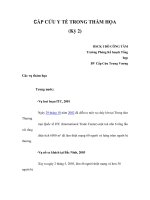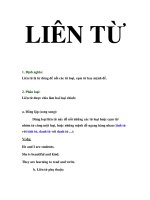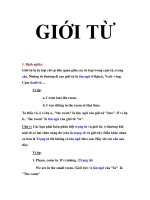Bài đọc 2.3. Chuyến viếng thăm Hoa Kỳ của Tổng bí thư Nguyễn Phú Trọng năm 2015 (Chỉ có bản tiếng Anh)
Bạn đang xem bản rút gọn của tài liệu. Xem và tải ngay bản đầy đủ của tài liệu tại đây (190.3 KB, 10 trang )
<span class='text_page_counter'>(1)</span><div class='page_container' data-page=1>
<i><b>Guest Lecture at FSPPM </b></i>
<i>6 September 2018 </i>
Ted Osius
Former US Ambassador to Vietnam
<b>Leadership. Let me tell you a story. </b>
I arrived in December 2014, a brand-new ambassador.
My predecessor, Dave Shear, had focused on strategic issues.
He had useful advice for me, including urging continued deepening ties with the
Communist Party.
He told me that while the government is important; the Party is more important.
I spent the first couple of months meeting Vietnam’s leaders.
I kept hearing a consistent message that Party General Secretary
Nguyen Phu Trong was interested in visiting the USA.
This was unusual and interesting.
I knew Trong was among a handful of hard-liners on the Politburo who were
suspicious of the USA.
Some of them thought we wanted to stir up a color revolution in Vietnam.
But changes were afoot.
</div>
<span class='text_page_counter'>(2)</span><div class='page_container' data-page=2>
half a dozen years of stepped-up bullying in the East Sea.
Contacts told me that a shift had taken place in the Politburo,
reflected by VN’s willingness to stand
– if not shoulder-to-shoulder, at least in the same room – with the Philippines.
The Philippines had filed a case in the Arbitral Tribunal in the Hague
saying China was seeking hegemony in the East Sea
using claims that had no basis in international law.
And Vietnam’s traditional means of working out disputes with China weren’t
working.
The usual method was to avoid entanglement with China’s rivals
while engaging Chinese counterparts at all
levels of the government and Party in order to placate Beijing.
But every dry season since 2009, Chinese bullying got worse.
Beijing backed its East Sea claims by flexing military and paramilitary muscle.
The Chinese said that U.S. was seeking a closer relationship with Vietnam
to make trouble in the region.
I think they had it backward:
China was bullying its ASEAN neighbors so much it was pushing them into
the arms of the USA.
Vietnam’s people certainly wanted a closer relationship with the United States.
90 percent considered the USA Vietnam’s closest friend.
</div>
<span class='text_page_counter'>(3)</span><div class='page_container' data-page=3>
The problem was, the U.S. President rarely met with Party Leaders, only with
heads of state.
So my first requests for considering an Oval Office meeting met with a no.
U.S. officials said a visit by Trong would be welcome,
but that he shouldn’t count on a meeting with President Obama.
A couple of months went by, and I learned more.
Minister of Public Security Tran Dai Quang had decided to visit the USA.
I made sure he got top-level meetings, and briefed him before his trip.
His visit was seen by many in Vietnam as the warm-up act for the General
Secretary’s visit.
Tran Dai Quang was also polishing his own foreign policy credentials
prior to January 2016 Party Congress.
Apparently, it worked, as he became President.
He visited the USA in March, it was a big success.
At that point, I came to a startling realization.
If I didn’t make the case for an Oval Office meeting for General Secretary Trong,
the visit wouldn’t happen.
And Washington was resistant.
So I began working channels.
Although I was new on the job, I knew that my role wasn’t to wait passively for
instructions.
</div>
<span class='text_page_counter'>(4)</span><div class='page_container' data-page=4>
Among them was my friend Tommy Vallely, who was quite skeptical.
But he listened to my explanation of why it would be important for Trong to visit.
And then he helped me persuade Secretary of State John Kerry that
an Oval Office meeting was needed.
Kerry went to see the President for one of their regular lunches.
He had been warned by National Security Adviser Susan Rice not to push for a
Trong visit.
But he did so anyway, over her head.
“I got beat up for making the case,” he told me, referring to one of his regular
tangles with
Dr. Rice. “But I got it done.”
The President agreed.
So I was able to say it’s approved In principle, but I don’t yet have a date.
China has certainly noticed that a visit was planned.
When Beijing learned of Trong’s pending trip to Washington,
Trong received and accepted a counter-invitation.
So, for four days in early April, Beijing rolled out the red carpet for Trong and his
entourage.
My Vietnamese interlocutors told me there visit was high on protocol
but there were no substantive results.
</div>
<span class='text_page_counter'>(5)</span><div class='page_container' data-page=5>
In Singapore, he said “The United States wants a “rising China” to play by the
rules.
Neither might nor past injuries, he explained, gave Beijing rights
to lands that it had never possessed in its imperial past;
nor was it in any state’s interest to dismiss the dispute resolution framework
created by international law.
So on the most critical strategic issue, the East Sea, we were on the same side as
Vietnam.
Secretary Carter and Defense Minister Phung Quang Thanh
signed a Joint Vision Statement on Defense Relations.
Among other provisions, it made it easier for Vietnam
to navigate U.S. regulations on the procurement of military hardware.
At a dinner with defense minister Phung Quang Thanh,
he and Ash Carter drank a fair amount of red wine.
After a while they talked about their families, and the Defense Secretary
asked the Minister where he had met his wife.
“She pulled shrapnel out of my hip,” Thanh said.
It was clear that Americans were responsible for that war injury.
Then out came some very fine Scotch.
After a few glasses and a lot of laughter, Thanh said,
“You know, if we had enjoyed a dinner like this back then,
there never would have been a war.”
</div>
<span class='text_page_counter'>(6)</span><div class='page_container' data-page=6>
If it hadn’t been clear before, Chairman of the Party’s External Relations
Committee made crystal clear Hanoi’s objectives when he published an op-ed in
the Washington Post.
He wrote that the visit by the general secretary at the invitation of the Obama
administration signals U.S. respect for Vietnam’s choice of political regime.
From the U.S. perspective, Trong was the key to including Vietnam in the TPP.
Deputy Secretary of State Tony Blinken published an article saying the U.S.
considered the Trong visit an opportunity to advance a trade deal that “if
achieved, will establish high standards on labor, intellectual property, and the
environment.
The trade agreement, he wrote, was a strategic opportunity for the entire region.
And Vietnam’s participation in TPP showed the rest of Asia that a developing
country could meet the high-standards of a modern trade deal with the United
States.
Only Trong could persuade the Party to accede to U.S. demands on free assembly
for Vietnamese workers, a key human rights provision that would be essential for
TPP to gain support from any Democratic lawmakers.
Also, Trong could facilitate the growth of security ties.
And only Trong could ensure that Vietnam’s partnership with the United States
would last.
</div>
<span class='text_page_counter'>(7)</span><div class='page_container' data-page=7>
had joined the White House a week earlier, asked what I thought the President
needed to say.
“The United States respects different political systems,” I told him.
“That will indicate that our intention is not to overthrow Vietnam’s government,
but to work with it.”
By way of explanation I added, “The greatest fear in Hanoi is that the United
States intends to stir up a ‘color revolution’ in Vietnam and bring down the
system of one-Party rule.
That’s why leaders in Hanoi are concerned about our demands for labor reform in
the Trans-Pacific Partnership.
If we want a constructive relationship with Hanoi, and want key concessions that
will bring Vietnam into the TPP, we must be clear that overthrowing the Party-led
government is not our intent.”
The Oval Office meeting, scheduled for 45 minutes, lasted twice that long and
broke historic ground.
President Obama stated clearly that the United States could respect political
systems different from our own.
He spoke respectfully but clearly about the importance the United States attaches
to human rights.
He urged Trong to agree to allow labor unions to associate freely, noting that
would be crucial if Vietnam were to join the TPP.
</div>
<span class='text_page_counter'>(8)</span><div class='page_container' data-page=8>
entire career.
How could he know how to be so effective, given the thousands of demands on
his time?
I had urged my friends in the Party to counsel Trong to jettison his notes,
and just have a conversation with President Obama.
“Look him in the eye,” I urged.
Trong did, and the two leaders connected.
The U.S. and Vietnam negotiated a joint statement that included a commitment
to “respect for…each other’s political systems,” the most important line in the
document.
There were other important commitments, such as continuing party-to-party
dialogues, dioxin clean-up, human rights, and TPP.
The leaders agreed to grant a license to Fulbright University Vietnam, and a
couple of days later in New York Trong agreed that Fulbright would enjoy
academic freedom.
Vietnam Airlines purchased Dreamliner Aircraft that would enable direct flights
between the two countries.
The US partially lifted its embargo on the sale of lethal weapons.
In the months that followed, the joint statement was read by Party leaders and
every member of the government and Party, right to the provincial level.
</div>
<span class='text_page_counter'>(9)</span><div class='page_container' data-page=9>
agreement.
For the first time in history, Vietnam would permit freedom of assembly for labor
unions, the biggest human rights concession the country had ever made.
A few months after the General Secretary’s visit, Vietnam committed in an agreed
side letter to “carry out whatever reforms may be necessary…with respect to
commitments relating to the 1998 ILO Declaration of Fundamental Principles and
Rights at Work.”
This carefully worded concession would effectively end the Communist Party’s
monopoly on labor unions and organized labor.
Stoutly resisted by conservatives in the Party, it was seen as the price that must
be paid for Vietnam to be included in a trade regime that embraced two of the
world’s three largest economies, and would give Vietnam strategic options as well
as access to the globe’s largest market.
It represented a huge step in the direction of greater prosperity for Vietnam, and
greater independence for Asian TPP member economies from the rapacious,
mercantilist policies of China.
In the two years following that Oval Office meeting, our embassy team was
empowered to expand bilateral collaboration in every area: security, trade,
education, science and technology, health and the environment.
Most important was trade.
Then-U.S. Trade Representative Michael Froman used the President’s meeting
with the General Secretary to nail down all the final details in our negotiations
</div>
<span class='text_page_counter'>(10)</span><div class='page_container' data-page=10>
As I look back on my three years as ambassador, I have concluded that facilitating
that meeting was the most consequential step I took.
The 2016 visit to Vietnam by President Obama was also very consequential,
but I don’t think it could have been so substantive without that visit by Nguyen
Phu Trong.
The 2017 visit to the US by Prime Minister Nguyen Xuan Phuc
and visit to Vietnam by President Trump were also important,
but again I’d argue their success was at least in part made possible by Trong’s
historic trip.
Each built on previous steps, such as President Truong Tan Sang’s visit to
Washington in 2013,
</div>
<!--links-->
Giải pháp hoàn thiện chiến lược phát triển thị trường dịch vụ vận chuyển hàng hoá QT của Tổng công ty hàng không Việt nam
- 144
- 1
- 10








